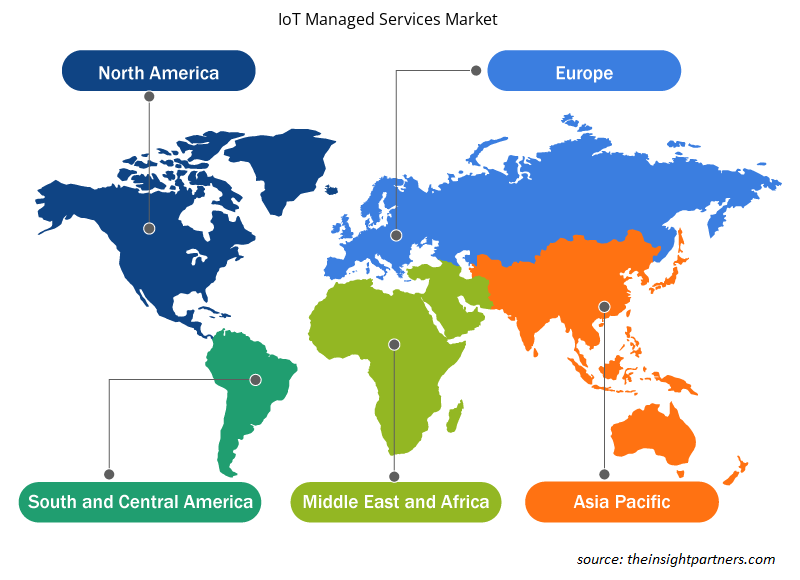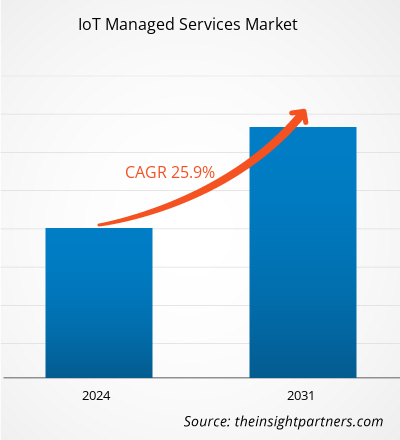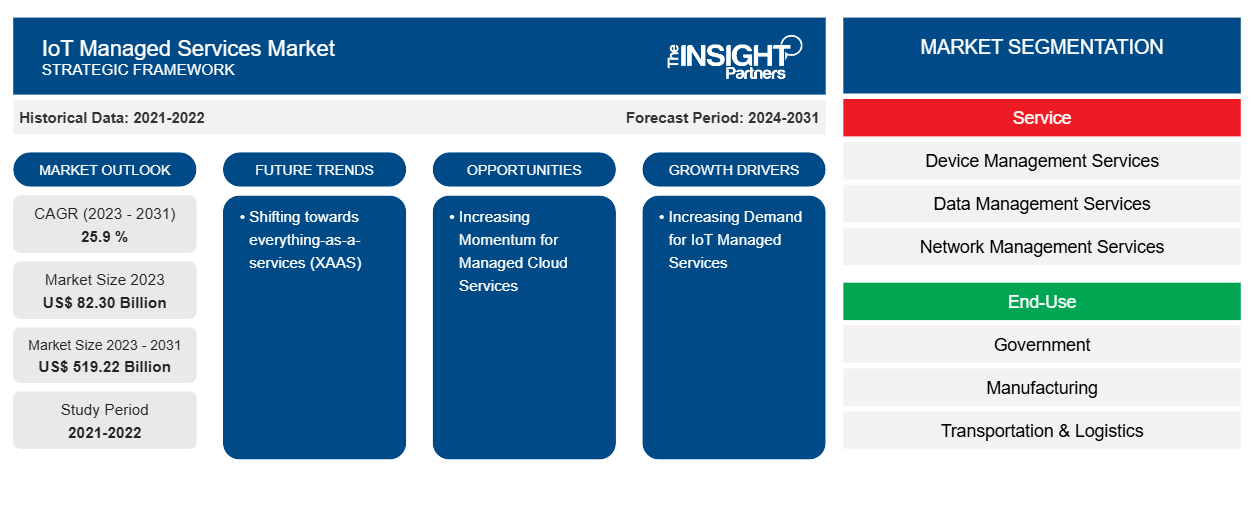Der Markt für IoT-Managed-Services soll von 82,30 Milliarden US-Dollar im Jahr 2023 auf 519,22 Milliarden US-Dollar im Jahr 2031 anwachsen. Der Markt für IoT-Managed-Services soll in den Jahren 2023–2031 eine durchschnittliche jährliche Wachstumsrate von 25,9 % verzeichnen. Der Ausbau von Multi-Cloud-Anwendungen, die zunehmende Automatisierung und die steigende Nachfrage nach IoT im industriellen Bereich treiben die Nachfrage nach IoT-Managed-Services weltweit an.
Marktanalyse für IoT Managed Services
Die Verbreitung von Multi-Cloud-Anwendungen, Automatisierung und die steigende Nachfrage nach IoT im industriellen Bereich treiben die Nachfrage nach IoT-verwalteten Diensten weltweit in die Höhe. Der Anstieg wird voraussichtlich durch technische Fortschritte und die Erschwinglichkeit von Sensoren und Prozessoren vorangetrieben, die Echtzeit-Informationszugriff ermöglichen. Die Nachfrage nach erhöhter Betriebskompetenz und hervorragender Zusammenarbeit zwischen den wichtigsten Branchenteilnehmern wird den Markt voraussichtlich ebenfalls antreiben. Die Ansätze zur Schaffung einer hybriden digital-menschlichen Belegschaft werden voraussichtlich erhebliches Wachstumspotenzial bieten.
Marktübersicht für IoT Managed Services
IoT-verwaltete Dienste können systematische Antworten auf Unternehmensprobleme liefern, die Betriebseffizienz steigern und neue Märkte erschließen, indem sie den Datenfluss zwischen verbundenen Geräten und dem elektronischen Kern nutzen. Der Markt für verwaltete Dienste für das Internet der Dinge umfasst vier Hauptdienste: Gerätetreiber, Infrastrukturdienste, Datensicherheitskontrolle und Netzwerküberwachung.
Passen Sie diesen Bericht Ihren Anforderungen an
Sie erhalten kostenlos individuelle Anpassungen an jedem Bericht, einschließlich Teilen dieses Berichts oder einer Analyse auf Länderebene, eines Excel-Datenpakets sowie tolle Angebote und Rabatte für Start-ups und Universitäten.
-
Holen Sie sich die wichtigsten Markttrends aus diesem Bericht.Dieses KOSTENLOSE Beispiel umfasst eine Datenanalyse von Markttrends bis hin zu Schätzungen und Prognosen.
Treiber und Chancen für den IoT Managed Services-Markt
Steigende Nachfrage nach IoT Managed Services begünstigt den Markt
Der Sektor der IoT-Managed-Services gewinnt rasch an Bedeutung. Der Einsatz von LTE und technische Durchbrüche in vielen Bereichen sind die Hauptgründe für den Markt der IoT-Managed-Services. Weit verbreitete IoT-Managed-Services-Anwendungen in den Bereichen Automobil, Unterhaltungselektronik und IT/Telekommunikation werden die Marktexpansion vorantreiben. Darüber hinaus blieben die Marktaussichten für die Sicherheit von IoT-Managed-Services positiv, was die Nachfrage nach IoT-Managed-Services noch weiter steigerte. Darüber hinaus wirkt sich die zunehmende Nutzung vernetzter Geräte wie Laptops, Wearables und Smartphones positiv auf das Marktwachstum aus. Der verstärkte Fokus auf die Verbesserung der Netzwerkkonnektivität beschleunigt das Wachstum des Marktes für IoT-Managed-Services.IoT managed services sector is rapidly gaining significant traction. LTE deployment and technical breakthroughs in many areas are the primary reasons driving the IoT managed services market. Widespread IoT managed services applications in automotive, consumer electronics, and IT/telecom will fuel market expansion. Furthermore, market prospects for IoT managed services security remained positive, which boosted demand for IoT managed services even more. Furthermore, the increasing use of connected devices such as laptops, wearables, and smartphones positively impacts the market growth. Increased focus on enhancing IoT managed services market growth.
Zunehmende Dynamik für Managed Cloud Services
Der IT-Sektor wechselt vom traditionellen zum Cloud-Hosting. Dies treibt das Wachstum von verwalteten Cloud-Diensten voran. Viele Unternehmen sind sich der Möglichkeiten der Cloud noch nicht bewusst und können sie nicht voll ausschöpfen. Daher beauftragen sie einen Drittanbieter für verwaltete Cloud-Dienste mit dieser Aufgabe. Diese Notwendigkeit treibt den Bedarf an verwalteten Cloud-Diensten voran. Cloud-Dienste sind ein wichtiger Trend in der Branche der ausgelagerten Dienste. MSPs konzentrieren sich hauptsächlich auf Managed Anything as a Service (XaaS), da sie ihre Dienste normalerweise über die Cloud bereitstellen. Cloud und IoT sind untrennbar miteinander verbunden, da IoT-Komponenten nicht mit Self-Storage konzipiert sind und die erstellten Daten daher in der Cloud gespeichert werden müssen. Insbesondere nutzen IoT-verwaltete Dienste Cloud-Plattformen, um ihre IoT-verwalteten Dienste an Unternehmen bereitzustellen.MSPs primarily focus on Managed Anything as a Service (XaaS), as they typically provide their services over the cloud. Cloud and IoT are inextricably linked since IoT components are not designed with self-storage, hence data created must be kept on the cloud. Specifically, IoT managed services are utilizing cloud platforms to deliver their IoT managed services to organizations.
Segmentierungsanalyse des Marktberichts zu verwalteten IoT-Diensten
Wichtige Segmente, die zur Ableitung der Marktanalyse für verwaltete IoT-Dienste beigetragen haben, sind Service und Endnutzung.
- Basierend auf dem Service ist der Markt für verwaltete IoT-Dienste in Geräteverwaltungsdienste, Datenverwaltungsdienste , Netzwerkverwaltungsdienste und Sicherheitsverwaltungsdienste segmentiert.
- Nach Endverbrauch ist der Markt in Regierung, Fertigung, Transport und Logistik, Energie und Versorgung, intelligentes Bauen und Wohnen, IT und Telekommunikation, Gesundheitswesen, BFSI und Einzelhandel segmentiert.
IoT Managed Services Marktanteilsanalyse nach Geografie
Der geografische Umfang des Marktberichts zu IoT-Managed-Services ist hauptsächlich in fünf Regionen unterteilt: Nordamerika, Asien-Pazifik, Europa, Naher Osten und Afrika sowie Süd- und Mittelamerika. Der Markt hat im asiatisch-pazifischen Raum aufgrund florierender Wirtschaftssektoren wie Gesundheitswesen, Sicherheit und Schutz, Fertigung, Energie und Landwirtschaft ein enormes Wachstumspotenzial. Durch die Einbindung von Blockchain und kryptografischen Verfahren in IoT-Sicherheitsdienste bietet IoT ein zentralisiertes Netzwerk und zugehöriges Datenmanagement, wodurch Unternehmensrisiken und Sicherheitsprobleme verringert und gleichzeitig das IoT auf dem regionalen Markt für Ingenieurdienstleistungen vorangetrieben wird.
Regionale Einblicke in den Markt für verwaltete IoT-Dienste
Die regionalen Trends und Faktoren, die den Markt für IoT Managed Services im Prognosezeitraum beeinflussen, wurden von den Analysten von Insight Partners ausführlich erläutert. In diesem Abschnitt werden auch die Marktsegmente und die Geografie von IoT Managed Services in Nordamerika, Europa, im asiatisch-pazifischen Raum, im Nahen Osten und Afrika sowie in Süd- und Mittelamerika erörtert.

- Holen Sie sich die regionalen Daten für den IoT Managed Services-Markt
Umfang des Marktberichts zu IoT Managed Services
| Berichtsattribut | Details |
|---|---|
| Marktgröße im Jahr 2023 | 82,30 Milliarden US-Dollar |
| Marktgröße bis 2031 | 519,22 Milliarden US-Dollar |
| Globale CAGR (2023 - 2031) | 25,9 % |
| Historische Daten | 2021-2022 |
| Prognosezeitraum | 2024–2031 |
| Abgedeckte Segmente |
Nach Service
|
| Abgedeckte Regionen und Länder |
Nordamerika
|
| Marktführer und wichtige Unternehmensprofile |
|
Dichte der Marktteilnehmer für IoT Managed Services: Die Auswirkungen auf die Geschäftsdynamik verstehen
Der Markt für IoT Managed Services wächst rasant, angetrieben durch die steigende Nachfrage der Endnutzer aufgrund von Faktoren wie sich entwickelnden Verbraucherpräferenzen, technologischen Fortschritten und einem größeren Bewusstsein für die Vorteile des Produkts. Mit steigender Nachfrage erweitern Unternehmen ihr Angebot, entwickeln Innovationen, um die Bedürfnisse der Verbraucher zu erfüllen, und nutzen neue Trends, was das Marktwachstum weiter ankurbelt.
Die Marktteilnehmerdichte bezieht sich auf die Verteilung der Firmen oder Unternehmen, die in einem bestimmten Markt oder einer bestimmten Branche tätig sind. Sie gibt an, wie viele Wettbewerber (Marktteilnehmer) in einem bestimmten Marktraum im Verhältnis zu seiner Größe oder seinem gesamten Marktwert präsent sind.
Die wichtigsten Unternehmen auf dem Markt für IoT-Managed-Services sind:
- Cisco Systems Inc.
- Bewusst
- Google Inc.
- Harman International
- HCL Technologies Limited
- IBM Corporation
Haftungsausschluss : Die oben aufgeführten Unternehmen sind nicht in einer bestimmten Reihenfolge aufgeführt.

- Überblick über die wichtigsten Akteure auf dem Markt für IoT Managed Services
IoT Managed Services Marktnachrichten und aktuelle Entwicklungen
Der Markt für IoT-Managed-Services wird durch die Erhebung qualitativer und quantitativer Daten nach Primär- und Sekundärforschung bewertet, die wichtige Unternehmenspublikationen, Verbandsdaten und Datenbanken umfasst. Nachfolgend sind einige der Entwicklungen auf dem Markt für IoT-Managed-Services aufgeführt:
- KORE, ein globaler Anbieter von Lösungen für das Internet der Dinge (IoT) und globaler IoT-Konnektivität als Service (IoT CaaS), hat eine Markteinführungsvereinbarung mit Google Cloud angekündigt, um IoT-Funktionen für Unternehmen auf der ganzen Welt bereitzustellen. Unternehmen können mithilfe der IoT-Lösungen von KORE sowie der Infrastruktur und Funktionen von Google Cloud effektive IoT-Lösungen entwickeln.
(Quelle: KORE, Pressemitteilung, 2022)
- HCL Technologies und SAP haben eine Zusammenarbeit bei branchenrelevanten IoT-Paketangeboten und -Diensten ins Leben gerufen. HCL Technologies ist ein globales Technologieunternehmen und ein für das Internet der Dinge (IoT) zertifiziertes Unternehmen. Bei der Umsetzung von Industrie 4.0-Transformationen müssen sich Unternehmen mit einem fragmentierten und komplexen Lösungsökosystem auseinandersetzen. HCL Technologies wird relevante SAP-Software mit Diensten und Hardware bündeln, um diesen Prozess zu beschleunigen und zu vereinfachen.
(Quelle: HCL Technologies, Pressemitteilung, 2022)
Marktbericht zu IoT Managed Services – Abdeckung und Ergebnisse
Der Bericht „IoT Managed Services-Marktgröße und -prognose (2021–2031)“ bietet eine detaillierte Analyse des Marktes, die die folgenden Bereiche abdeckt:
- IoT Managed Services Marktgröße und Prognose auf globaler, regionaler und Länderebene für alle wichtigen Marktsegmente, die im Rahmen des Berichts abgedeckt sind
- Markttrends für IoT-Managed-Services sowie Marktdynamiken wie Treiber, Einschränkungen und wichtige Chancen
- Detaillierte PEST/Porters Five Forces- und SWOT-Analyse
- Marktanalyse für verwaltete IoT-Dienste mit wichtigen Markttrends, globalen und regionalen Rahmenbedingungen, wichtigen Akteuren, Vorschriften und aktuellen Marktentwicklungen
- Branchenlandschaft und Wettbewerbsanalyse, die die Marktkonzentration, Heatmap-Analyse, prominente Akteure und aktuelle Entwicklungen für den Markt für IoT-Managed-Services umfasst
- Detaillierte Firmenprofile
- Historische Analyse (2 Jahre), Basisjahr, Prognose (7 Jahre) mit CAGR
- PEST- und SWOT-Analyse
- Marktgröße Wert/Volumen – Global, Regional, Land
- Branchen- und Wettbewerbslandschaft
- Excel-Datensatz
Aktuelle Berichte
Erfahrungsberichte
Grund zum Kauf
- Fundierte Entscheidungsfindung
- Marktdynamik verstehen
- Wettbewerbsanalyse
- Kundeneinblicke
- Marktprognosen
- Risikominimierung
- Strategische Planung
- Investitionsbegründung
- Identifizierung neuer Märkte
- Verbesserung von Marketingstrategien
- Steigerung der Betriebseffizienz
- Anpassung an regulatorische Trends























 Kostenlose Probe anfordern für - Markt für IoT Managed Services
Kostenlose Probe anfordern für - Markt für IoT Managed Services